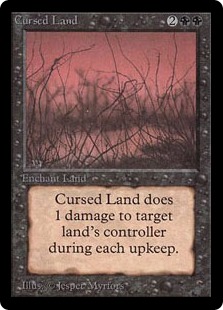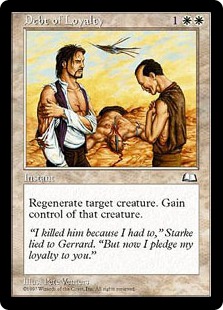Once upon a midnight dreary, while I pondered, weak and weary,
Over many a quaint and curious volume of forgotten lore—
Of a time passed, players kneeling, both with unsure concrete feeling,
Over how we should be dealing, dealing with words upon the floor.
Unsure errata, nevermore.
It’s strange for me to realize that I am part of the final generation who vividly remembers growing up in a time before the Internet as we know it existed in almost every home, before it permeated into every aspect of our society and fundamentally changing everything. Prior to that, information took a little more time to circulate. The idea of instantaneous information for mass consumption wasn’t quite there yet, whether it was an important new scientific finding, or the changes to a fledgling collectible card game.
Even once the idea of the World Wide Web took off, getting everyone on the same page in Magic was tricky. Before Gatherer existed, before Magiccards.info, before Crystal Keep, there was a series of early online usenets and message forums for tech-savvy players and judges to communicate with one another semi-quickly regarding updates and clarifications for the game. For everyone else though, you either relied on the Duelist, InQuest, or Scrye magazines (if you had the desire or money to spend on them), or more commonly, you relied on word of mouth.
Magic underwent a series of significant changes and fixes from Alpha through Sixth Edition. If you think the shifts that happened with Magic 2010 were something, you’d be amazed at how frequently things during the game’s first six years. You’d also likely be heavily confused. We certainly were.
In addition to an abundance of clunky, confusing, and arbitrarily complicated aspects to the game that you had to contend with, there was a piecemeal approach to correcting them until they finally did the Sixth Edition overhaul. For younger players during this formidable era, Magic was far more unrefined than it is now, and yet many of us wear our rose-colored Sunglasses of Urza and remember it more fondly than it probably was. Like soldiers making through a hellish war, we emerged on the other side of that experience believing we were all the better for it.
Still, dealing with all of those changes as they came was a pain. And, because of our lack of instantaneous rules checking, none of those was more frustrating to a casual play group than errata.
Back then, there were three ways you could handle card changes. The first was to have a friend who followed such things pretty regularly, through said early Internet or magazines, and share that information throughout their play group. Barring that, players either made a house ruling on it until you got confirmation otherwise – this happened a lot – or you went strictly based on the card printing. That latter option was the easiest, but it also created a weird side effect years later in that you got an entire array of people who then refused to accept errata on cards even when the changes became more readily available.
 Nowadays almost everyone can check card errata, and these workarounds are all mostly moot. But back then, errata was often contentious.
Nowadays almost everyone can check card errata, and these workarounds are all mostly moot. But back then, errata was often contentious.
For instance, around the time of Tempest, I played regularly against a monoblack deck that was fueled by vampires and swampwalk creatures and whose figurehead was Baron Sengir. The deck also contained a Cursed Land. Not just any copy of Cursed Land, mind you. This was a Beta Cursed Land. The text from the Revised edition onward specified that it deals 1 damage to the land’s controller during their upkeep, but prior to that it was worded such that it deals a damage each upkeep. And since this person had the earlier copy, they insisted on the card wording as it was printed. Being much younger, and in that era of Magic, I had much less of an argument against that than I would now.
That said, I did die to that stupid Aura. A lot.
As it happens, this week’s card is another such example of a card that, as printed, seems far more powerful than it is.
Today we have: Debt of Loyalty

Name: Debt of Loyalty
Edition: Weatherlight
Rarity: Rare
Focus: Destruction Prevention / Creature Stealing
Highlights: Debt of Loyalty didn’t excite a whole lot of people when it first game out, in part because the way regeneration worked then was even more wonky than it is today.
When the 6th Edition rules changes came about, it made Debt of Loyalty function as intended, but there was a lot of confusion over whether the creature still had to actually regenerate for you to gain control of it. (It does.) This was later clarified, but by then many players had moved on.
In Commander, what’s old is often new again, and Debt of Loyalty makes for a fantastic surprise card in White – especially since, while fitting flavor wise, by today’s standards this would probably be a Blue / Green or Black / Blue card. For three mana, this card says that the next time a targetable creature would die, instead you gain control of it. Fortunately, creatures die a lot in Commander, and even more fortunately, White is one of the best colors at board wipes – which makes for some advantageous pairings with this card.
For a mere three mana investment, not only can you survive most board clears with something left over, but you can choose any creature. Perhaps you save your own creature. Or perhaps you take your opponent’s most useful asset. This could be a useful utility creature or a giant beatstick of a creature, but it’s also incredibly potent against a dying Commander. Debt of Loyalty allows you to snatch it from the clutches of death and sends it over to your side, which could be highly problematic for your enemy.
On top of that, this card is an Instant, letting you cast it at the most opportune time. When the card was originally printed, it could only be usefully cast right as a creature was going to die, as opposed to now when you can technically cast it at any point and the regen shield will stay on it until the end of the turn. Still, while a fun anecdote, the vast majority of the time you will still wait until the best time to stay the death knell of your enemy’s creature and it owe you life debt.
Ultimately, card-clarifying errata, much like rules tweaks, have shown that they are a necessary part of a game’s longevity. Not every ambiguity or mistake of a card is caught in time, and even things that seem benign can cause significant rules headaches later on. (Humility could get several articles unto itself on that point.) Sometimes cards may seem more or less powerful as a result, but it all balances out in the end.
Keep an eye out for us to be regularly featuring other more accessible-but-worth-it Commander cards going forward. In the meantime, we’ll keep the light on for you.
![]()
You can discuss this article over on our social media!
Do you have a particular Commander card to suggest for us to shine a future Spotlight on? You can send suggestions to ryan@cardboardrepublic.com
